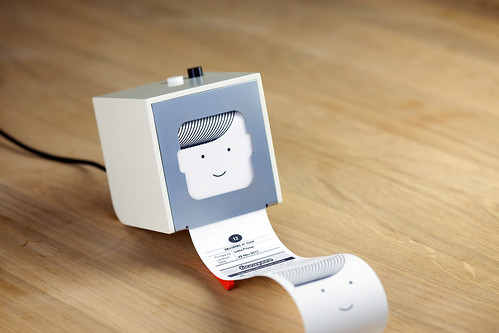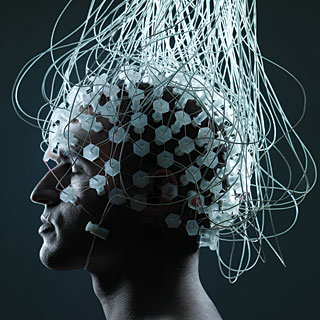Jul 23, 2013
The beginning of infinity
A little old video but still inspiring...
THE BEGINNING OF INFINITY from Jason Silva on Vimeo.
22:46 Posted in Blue sky | Permalink | Comments (0)
Aug 04, 2012
Is Little Printer the next (little) thing?
Yes! Definitely yes!
Little Printer lives in your home, bringing you news, puzzles and gossip from your friends. Use your smartphone to set up subscriptions and Little Printer will gather them together to create a timely, beautiful mini-newspaper.
For more see:
bergcloud.com/littleprinter/

19:34 Posted in Blue sky | Permalink | Comments (0)
The Virtual Brain
The Virtual Brain project promises "to deliver the first open simulation of the human brain based on individual large-scale connectivity", by "employing novel concepts from neuroscience, effectively reducing the complexity of the brain simulation while still keeping it sufficiently realistic".
The Virtual Brain team includes well-recognized neuroscientists from all over the world. In the video below, Dr. Randy McIntosh explains what the project is about.
First teaser release of The Virtual Brain software suite is available for download – for Windows, Mac and Linux: http://thevirtualbrain.org/
13:34 Posted in Blue sky, Neurotechnology & neuroinformatics, Research tools | Permalink | Comments (0)
Mar 31, 2012
Hyper(reality) - The Last Tuesday Society
Project's description: Embodying the concept theorized by hyperrealism theories, the helmet provides a digital experience, immersing the user in an alternative version of reality seen through the helmet. Instead of having a static point of view, the user becomes able to navigate through the 3D environment enabling new behaviours specific to the hyperreal world while still having to physically interact with the real environment. Thus it creates an odd interface between these two states.
Hyper(reality) - The Last Tuesday Society from Maxence
The suit is composed of an helmet with high definition video glasses, an arduino glove with force sensors controlling the 3D view and a harness for the kinect. Each user experience is recorded and analysed, portraiting user behaviours during the experience. Immersed into this dream-like virtual space, the user gradually discovers the collection of curiosities. Behaviours are being modified, the notion of scale is being distorted, all this pushing the boundaries of the physical space. Venitian masks, stuffed animals and old scultpures start floating in the air around the user creating a new sensorial experience.
13:03 Posted in Augmented/mixed reality, Blue sky | Permalink | Comments (0)
OutRun: Augmented Reality Driving Video Game
12:59 Posted in Augmented/mixed reality, Blue sky | Permalink | Comments (0)
Mar 11, 2012
Augmenting cognition: old concept, new tools
The increasing miniaturization and computing power of information technology devices allow new ways of interaction between human brains and computers, progressively blurring the boundaries between man and machine. An example is provided by brain-computer interface systems, which allow users to use their brain to control the behavior of a computer or of an external device such as a robotic arm (in this latter case, we speak of “neuroprostetics”).

The idea of using information technologies to augment cognition, however, is not new, dating back in 1950’s and 1960’s. One of the first to write about this concept was british psychiatrist William Ross Ashby.

In his Introduction to Cybernetics (1956), he described intelligence as the “power of appropriate selection,” which could be amplified by means of technologies in the same way that physical power is amplified. A second major conceptual contribution towards the development of cognitive augmentation was provided few years later by computer scientist and Internet pioneer Joseph Licklider, in a paper entitled Man-Computer Symbiosis (1960).

In this article, Licklider envisions the development of computer technologies that will enable users “to think in interaction with a computer in the same way that you think with a colleague whose competence supplements your own.” According to his vision, the raise of computer networks would allow to connect together millions of human minds, within a “'thinking center' that will incorporate the functions of present-day libraries together with anticipated advances in information storage and retrieval.” This view represent a departure from the prevailing Artificial Intelligence approach of that time: instead of creating an artificial brain, Licklider focused on the possibility of developing new forms of interaction between human and information technologies, with the aim of extending human intelligence.
A similar view was proposed in the same years by another computer visionnaire, Douglas Engelbart, in its famous 1962 article entitled Augmenting Human Intellect: A Conceptual Framework.

In this report, Engelbart defines the goal of intelligence augmentation as “increasing the capability of a man to approach a complex problem situation, to gain comprehension to suit his particular needs, and to derive solutions to problems. Increased capability in this respect is taken to mean a mixture of the following: more-rapid comprehension, better comprehension, the possibility of gaining a useful degree of comprehension in a situation that previously was too complex, speedier solutions, better solutions, and the possibility of finding solutions to problems that before seemed insoluble (…) We do not speak of isolated clever tricks that help in particular situations.We refer to away of life in an integrated domain where hunches, cut-and-try, intangibles, and the human ‘feel for a situation’ usefully co-exist with powerful concepts, streamlined terminology and notation, sophisticated methods, and high-powered electronic aids.”
These “electronic aids” nowdays include any kind of harware and software computing devices used i.e. to store information in external memories, to process complex data, to perform routine tasks and to support decision making. However, today the concept of cognitive augmentation is not limited to the amplification of human intellectual abilities through external hardware. As recently noted by Nick Bostrom and Anders Sandberg (Sci Eng Ethics 15:311–341, 2009), “What is new is the growing interest in creating intimate links between the external systems and the human user through better interaction. The software becomes less an external tool and more of a mediating ‘‘exoself’’. This can be achieved through mediation, embedding the human within an augmenting ‘‘shell’’ such as wearable computers (…) or virtual reality, or through smart environments in which objects are given extended capabilities” (p. 320).
At the forefront of this trend is neurotechnology, an emerging research and development field which includes technologies that are specifically designed with the aim of improving brain function. Examples of neurotechnologies include brain training games such as BrainAge and programs like Fast ForWord, but also neurodevices used to monitor or regulate brain activity, such as deep brain stimulators (DBS), and smart prosthetics for the replacement of impaired sensory systems (i.e. cochlear or retinal implants).

Clearly, the vision of neurotechnology is not free of issues. The more they become powerful and sophisticated, the more attention should be dedicated to understand the socio-economic, legal and ethical implications of their applications in various field, from medicine to neuromarketing.
Jan 27, 2012
Positive Technology: Using Interactive Technologies to Promote Positive Functioning
Positive Technology: Using Interactive Technologies to Promote Positive Functioning
G. Riva, R.M. Baños, C. Botella, B.K. Wiederhold, A. Gaggioli
Cyberpsychology, Behavior, and Social Networking (Online Ahead of Print: December 9, 2011) DOI
Abstract. It is generally assumed that technology assists individuals in improving the quality of their lives. However, the impact of new technologies and media on well-being and positive functioning is still somewhat controversial. In this paper, we contend that the quality of experience should become the guiding principle in the design and development of new technologies, as well as a primary metric for the evaluation of their applications. The emerging discipline of Positive Psychology provides a useful framework to address this challenge. Positive Psychology is the scientific study of optimal human functioning and flourishing. Instead of drawing on a “disease model” of human behavior, it focuses on factors that enable individuals and communities to thrive and build the best in life. In this paper, we propose the “Positive Technology” approach—the scientific and applied approach to the use of technology for improving the quality of our personal experience through its structuring, augmentation, and/or replacement—as a way of framing a suitable object of study in the field of cyberpsychology and human–computer interaction. Specifically, we suggest that it is possible to use technology to influence three specific features of our experience—affective quality, engagement/actualization, and connectedness—that serve to promote adaptive behaviors and positive functioning. In this framework, positive technologies are classified according to their effects on a specific feature of personal experience. Moreover, for each level, we have identified critical variables that can be manipulated to guide the design and development of positive technologies.
19:34 Posted in Blue sky, Positive Technology events | Permalink | Comments (0)
Dec 31, 2011
10 videos on our near future
10:41 Posted in Blue sky | Permalink | Comments (0)
Nov 26, 2011
Curiosity (did not) kill the cat
Today at 10:02 am the latest Mars Rover, Curiosity was launched into the deep space. The $2.5 billion exploratory system started its eight month journey to Mars where it will spend another two years researching the conditions for (past or future) life. The nuclear-powered Curiosity is much larger than any previous Mars Rover and five times heavier. Its equipment includes a drill on a 2.1-meter arm and a laser to vaporize rocks for easier onboard analysis.
When I first watched this video this morning I was really amazed by the technology, the landing strategy and the terrific level of sophistication of the rover system. Then I thought to myself - if there is enough brainpower on earth to make this vision a reality, then it must be also possible to workout a solution for the global economy!
19:50 Posted in AI & robotics, Blue sky | Permalink | Comments (0)
Nov 06, 2011
A view of future productivity
A future vision of productivity from Microsoft
15:36 Posted in Blue sky, Future interfaces | Permalink | Comments (0)
Jul 27, 2011
A robot that flies like a bird
The poetry of technology..
00:07 Posted in AI & robotics, Blue sky | Permalink | Comments (0)
Jun 05, 2011
Human Computer Confluence
Human Computer Confluence (HC-CO) is an ambitious initiative recently launched by the European Commission under the Future and Emerging Technologies (FET) program, which fosters projects that investigate and demonstrate new possibilities “emerging at the confluence between the human and technological realms” (source: HC-CO website, EU Commission).
Such projects will examine new modalities for individual and group perception, actions and experience in augmented, virtual spaces. In particular, such virtual spaces would span the virtual reality continuum, also extending to purely synthetic but believable representation of massive, complex and dynamic data. HC-CO also fosters inter-disciplinary research (such as Presence, neuroscience, psychophysics, prosthetics, machine learning, computer science and engineering) towards delivering unified experiences and inventing radically new forms of perception/action.
HC-CO brings together ideas stemming from two series of Presence projects (the complete list is available here) with a vision of new forms of interaction and of new types of information spaces to interact with. It will develop the science and technologies necessary to ensure an effective, even transparent, bidirectional communication between humans and computers, which will in turn deliver a huge set of applications: from today's Presence concepts to new senses, to new perceptive capabilities dealing with more abstract information spaces to the social impact of such communication enabling technologies. Inevitably, these technologies question the notion of interface between the human and the technological realm, and thus, also in a fundamental way, put into question the nature of both.
The long-term implications can be profound and need to be considered from an ethical/societal point of view. HC-CO is, however, not a programme on human augmentation. It does not aim to create a super-human. The idea of confluence is to study what can be done by bringing new types of technologically enabled interaction modalities in between the human and a range of virtual (not necessarily naturalistic) realms. Its ambition is to bring our best understanding from human sciences into future and emerging technologies for a new and purposeful human computer symbiosis.
HC-CO is conceptually broken down into the following themes:
- HC-CO Data. On-line perception and interaction with massive volumes of data: new methods to stimulate and use human sensory perception and cognition to interpret massive volumes of data in real time to enable assimilation, understanding and interaction with informational spaces. Research should find new ways to exploit human factors (sensory, perceptual and cognitive aspects), including the selection of the most effective sensory modalities, for data exploration. Although not explicitly mentioned, non-sensorial pathways, i.e., direct brain to computer and computer to brain communication could be explored.
- HC-CO Transit. Unified experience, emerging from the unnoticeable transition from physical to augmented or virtual reality: new methods and concepts towards unobtrusive mixed or virtual reality environment (multi-modal displays, tracking systems, virtual representations...), and scenarios to support entirely unobtrusive interaction. Unobtrusiveness also applies to virtual representations, their dynamics, and the feedback received. Here the challenge is both technological and scientific, spanning human cognition, human machine interaction and machine intelligence disciplines.
- HC-CO Sense. New forms of perception and action: invent and demonstrate new forms of interaction with the real world, virtual models or abstract information by provoking a mapping from an artificial medium to appropriate sensory modalities or brain regions. This research should reinforce data perception and unified experience by augmenting the human interaction capabilities and awareness in virtual spaces.
In sum, HC-CO is an emerging r&d field that holds the potential to revolutionize the way we interact with computers. Standing at the crossroad between cognitive science, computer science and artificial intelligence, HC-CO can provide the cyberpsychology and cybertherapy community with fresh concepts and interesting new tools to apply in both research and clinical domains.
More to explore:
- HC-CO initiative: The official EU website the HC-CO initiative, which describes the broad objectives of this emerging research field.
- HC2 Project: The horizontal character of HC-CO makes it a fascinating and fertile interdisciplinary field, but it can also compromise its growth, with researchers scattered across disciplines and groups worldwide. For this reason a coordination activity promoting discipline connect, identity building and integration while defining future research, education and policy directions at the regional, national, European and international level has been created. This project is HC2, a three-year Coordination Action funded by the FP7 FET Proactive scheme. The consortium will draw on a wide network of researchers and stakeholders to achieve four key objectives: a) stimulate, structure and support the research community, promoting identity building; b) to consolidate research agendas with special attention to the interdisciplinary aspects of HC-CO; c) enhance the Public Understanding of HC-CO and foster the early contact of researchers with high-tech SMEs and other industry players; d) establish guidelines for the definition of new educational curricula to prepare the next generation of HC-CO researchers.
- CEED Project: Funded by the HC-CO initiative, the Collective Experience of Empathic Data Systems (CEEDs) project aims to develop “novel, integrated technologies to support human experience, analysis and understanding of very large datasets”. CEEDS will develop innovative tools to exploit theories showing that discovery is the identification of patterns in complex data sets by the implicit information processing capabilities of the human brain. Implicit human responses will be identified by the CEEDs system’s analysis of its sensing systems, tuned to users’ bio-signals and non-verbal behaviours. By associating these implicit responses with different features of massive datasets, the CEEDs system will guide users’ discovery of patterns and meaning within the datasets.
- VERE Project: VERE - Virtual Embodiment and Robotic Re-Embodiment – is another large project funded by the HC-CO initiative, which aims at “dissolving the boundary between the human body and surrogate representations in immersive virtual reality and physical reality”. Dissolving the boundary means that people have the illusion that their surrogate representation is their own body, and act and have thoughts that correspond to this. The work in VERE may be thought of as applied presence research and applied cognitive neuroscience.
Dec 27, 2010
Post-apocalyptic Tokyo scenery
fantastic photo manipulations by Tokyogenso. See more here

17:30 Posted in Blue sky, Creativity and computers, Cyberart | Permalink | Comments (0)
Sep 02, 2010
The Blue Brain Project
As computing power continues to increase, it may ultimately be possible to simulate the functioning of the most complex system of the known universe: the brain. This is the ambitious goal of the Blue Brain Project, the first attempt to reverse-engineer the mammalian brain.
The project is expected to provide answers to a number of fundamental questions, ranging from the emergence of biological intelligence to the evolution of consciousness.
Lead by neuroscientist Henry Markram, Blue Brain was launched in 2005 as a joint research initiative between the Brain Mind Institute at the École Polytechnique Fédérale de Lausanne (EPFL) and the information technology giant IBM. Using the impressive processing power of IBM’s Blue Gene/L supercomputer, the project reached its first milestone in December 2006, with the development of the model of a rat’s neocortical column (NCC).
To perform the empirically-based simulation of individual cells, the Blue Gene/L supercomputer uses the NEURON software developed by Michael Hines, John W. Moore, and Ted Carnevale at Yale and Duke. Thanks to this software, processors are converted into neuron simulators and communication cables are converted into axons interconnecting the neurons, which allows to transform the entire Blue Gene into a cortical microcircuit.
In November 2007, the project achieved the completion of its first phase, with the development of a new modelling framework for the construction and validation of neural circuits built from biological data. The project is now striving to simplify the simulation of the column, in order to allow the parallel simulation of multiple connected columns. If this strategy will be successful, the final objective will be to simulate a whole human neocortex, which includes about one million cortical columns.
More to explore:
H. Markram, The Blue Brain Project, Nature Reviews Neuroscience, 7:153-160, 2006
18:55 Posted in Blue sky | Permalink | Comments (0) | Tags: blue brain, neuroinformatics, brain simulation
Jan 09, 2010
Simon's Cat 'Fly Guy'
A hungry cat resorts to increasingly desperate measures to catch a housefly.
13:21 Posted in Blue sky | Permalink | Comments (0)
Dec 20, 2009
Famous thoughts on manuscript reviews
from Edward Ross (Division of Nephrology, Hypertension & Transplantation, UFla) in The Lancet today …
To die while awaiting the review… alone.
Ernest Hemingway
It is the nature of reviews to be late.
Aristotle
I invented slow manuscript reviews.
Al Gore
There is more to life than simply increasing the speed of manuscript reviews.
Gandhi
I deny reviewing any author. What is your definition of reviewing?
Bill Clinton
Am I late, did I miss the date? It is so sad, this work is bad.
Dr Seuss
Imagine all the reviews in the world being returned, on time, in peace.
John Lennon
Hasten the review slowly.
Augustus Caesar
All things come round to the author who will but wait.
Henry Wadsworth Longfellow
The review isn’t over until it’s over.
Yogi Berra
Never in the field of manuscript conflicts was so much owed by so many authors to so few tardy reviewers.
Winston Churchill
Is the review really late, or is the rest of the world moving faster?
Albert Einstein
20:33 Posted in Blue sky | Permalink | Comments (0) | Tags: reviews, manuscript, the lancet
Dec 14, 2009
Get relief from stress
Stressed by technology? Let out your office anger and smash up your computer!
12:09 Posted in Blue sky | Permalink | Comments (0) | Tags: stress, serious games
Dec 12, 2009
Especially When The October Wind
by Dylan Thomas
Especially when the October wind
With frosty fingers punishes my hair,
Caught by the crabbing sun I walk on fire
And cast a shadow crab upon the land,
By the sea's side, hearing the noise of birds,
Hearing the raven cough in winter sticks,
My busy heart who shudders as she talks
Sheds the syllabic blood and drains her words.
Shut, too, in a tower of words, I mark
On the horizon walking like the trees
The wordy shapes of women, and the rows
Of the star-gestured children in the park.
Some let me make you of the vowelled beeches,
Some of the oaken voices, from the roots
Of many a thorny shire tell you notes,
Some let me make you of the water's speeches.
Behind a post of ferns the wagging clock
Tells me the hour's word, the neural meaning
Flies on the shafted disk, declaims the morning
And tells the windy weather in the cock.
Some let me make you of the meadow's signs;
The signal grass that tells me all I know
Breaks with the wormy winter through the eye.
Some let me tell you of the raven's sins.
Especially when the October wind
(Some let me make you of autumnal spells,
The spider-tongued, and the loud hill of Wales)
With fists of turnips punishes the land,
Some let me make of you the heartless words.
The heart is drained that, spelling in the scurry
Of chemic blood, warned of the coming fury.
By the sea's side hear the dark-vowelled birds.
12:46 Posted in Blue sky | Permalink | Comments (0) | Tags: dylan thomas, blue sky








